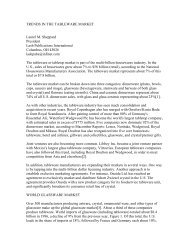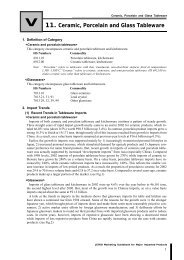Appendices to CBI Export Planner - crecer
Appendices to CBI Export Planner - crecer
Appendices to CBI Export Planner - crecer
Create successful ePaper yourself
Turn your PDF publications into a flip-book with our unique Google optimized e-Paper software.
<strong>CBI</strong> <strong>Export</strong> <strong>Planner</strong>you are reading this <strong>CBI</strong> <strong>Export</strong> <strong>Planner</strong>.But before you do, ask yourself why. This is the moment <strong>to</strong> balance the blessings ofoperating on a market that you know well against venturing in<strong>to</strong> a world unknown - andusually hard <strong>to</strong> enter.Strategic reasons <strong>to</strong> expand abroadOne thing should be clear from the start: exporting is not easy. In fact, it is morecomplicated, more risky and more expensive than operating on the domestic market.Most Small and Medium-sized Enterprises (SME), <strong>to</strong> which category 9 out of 10companies belong, are dedicated <strong>to</strong> manufacturing rather than trading. As such, trading isof secondary importance and usually restricted <strong>to</strong> the familiar home market. Trading <strong>to</strong>foreign cus<strong>to</strong>mers, as demanding as the competition makes it, could be beyond thecompany’s abilities. That is why you should think twice before deciding on export- orwhichever method you choose <strong>to</strong> sell your products and services abroad. You will take amoment <strong>to</strong> consider the options for internationalization, knowing it will require a lot ofmoney, time, talents and dedication, which could stress the corporate resources <strong>to</strong> theirlimits. The responsibility for the use of - invariably scarce - resources lies with the <strong>to</strong>pmanagement of the company. Therefore, the decision <strong>to</strong> use secure resources should bewell-balanced between possible yields and costs.The final balance is not only an economical one, which calculates export feasibility (seeChapter VI). You are aware that your product can be sold, provided it matches good valuewith a low price. But you don’t know whether you could make a profit selling it. Youknow that profit may be less than normal because you may have <strong>to</strong> sacrifice some profitwhen paying for the costs of shipping your goods <strong>to</strong> the target markets. But you do notknow if you could ask a higher price in far-away, more affluent markets. So, otherstrategic motives must also be weighed in the decision.Many exporters have preceded you in trying their luck in foreign markets. Some of themhad good reasons. Their motives were, for instance:• higher sales, higher turnover, more profits, or:• co-operating with trade partners in industrialised countries might stimulate mydevelopment, will give me access <strong>to</strong> new technology and make my organisation becomemore effective.Others have motives of a tactical nature, like:• the local market is saturated, it does not allow for growth, or:• avoiding the competition, or, on the contrary:• following the competition in newly opened markets;Others have opportunistic reasons <strong>to</strong> export:• <strong>to</strong> sell overproduction,• <strong>to</strong> exploit spare capacity,• <strong>to</strong> spread the costs over production and/or the costs of product development over moreunits sold (which decreases cost prices and increases competitiveness).All these motives are good.However, there have been exporters who ventured in<strong>to</strong> foreign markets for the wrongreasons. Their motives were personal ambition or corporate prestige. Or they were just6 I - Management: goals, resources and <strong>to</strong>ols





